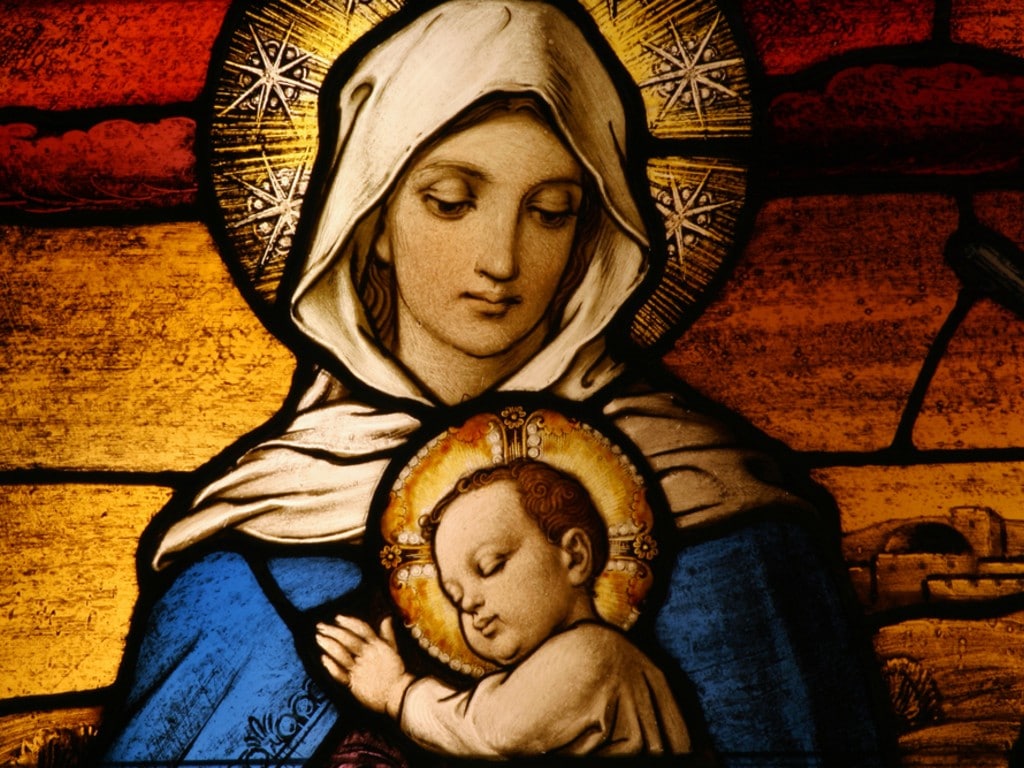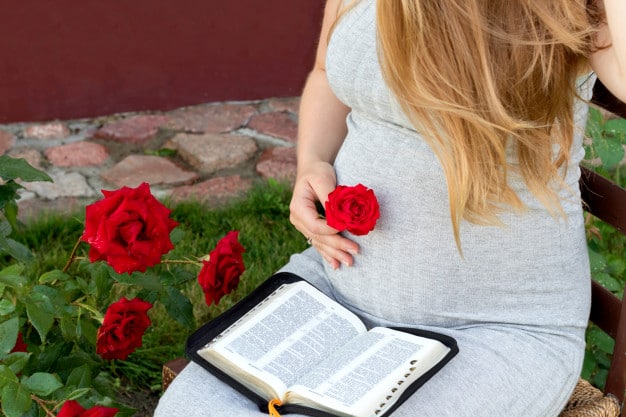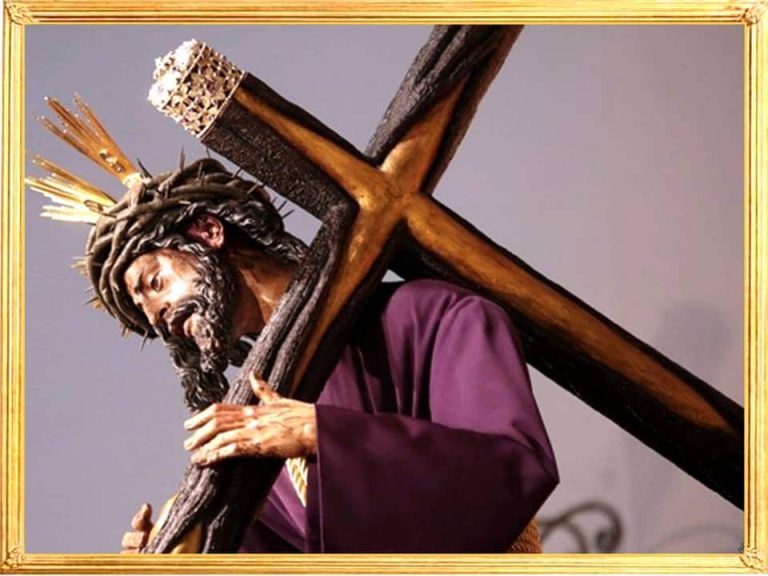Marian dogmas and the doctrines of the Church
Marian dogmas are considered truths that are not subject to doubt, revision or criticism and that, as their name indicates, are based or centered on the Virgin Mary.
Marian doctrines and dogmas give us a vision of the Mother of God, as one of the most important figures in Christianity and in the history of humanity, who must be respected and venerated.
Marian Dogmas
The dogmas are absolute and irrefutable truths, which every Catholic Christian accepts as true. When they refer to Marian dogmas, they are those propositions that have the figure of the Virgin Mary as their center.
There are four Marian dogmas, that is, absolute truths that are connected to Mary, defined by the Pope and by the teaching authority of the church.
They are proposed because we believe in them, and the Catholic faithful are not free to disagree with them.
The Marian dogmas are the Perpetual Virginity of Mary, the Divine Maternity, the Immaculate Conception of the Virgin and the Assumption of the Virgin Mary.
perpetual virginity of Mary
The Church traditionally presents Mary as a ” virgin before, during and after childbirth “, declaring and indicating that throughout her life, even in these crucial opportunities, she never ceased to be a virgin.
The angel Gabriel revealed to Mary that she would conceive and bear a child by the power of the Holy Spirit, despite her virginity.
Your physical and spiritual virginity has been consecrated to God and maintained all the time, that is why we call it perpetual virginity.
In the book of Isaiah, the prophet says that: “ the Virgin will conceive and give birth to a son ” (Isaiah 7, 14).
In this way, she virginally conceived Jesus without physical corruption. Mary’s birth is also considered to be virginal, that is, also without physical corruption.
The Second Vatican Council says that the birth of Christ “ did not diminish his virginal integrity, but rather consecrated it ” (Lumen Gentium 57) “and it is considered one of the Marian dogmas.
Mary is a perfect model of purity, holiness and dedication, always cooperating with the divine plan.
Divine Motherhood
Another of the Marian dogmas tells us that Mary is truly the Mother of God, since she gave birth to the Second Person of the Trinity, who became man to save humanity.
In the East they refer to this dogma with the original Greek term for Mary, Theotokos, which means “bearer of God”.
Mary of Nazareth, the Virgin, is clearly the mother of Jesus, she carried him in her womb, gave birth, sheltered him in her lap and raised him with the help of her husband Joseph.
How can we say that Mary is the mother of God himself? Because God is actually a Trinity: one God in three persons and Mary is the mother of the Second Person of the Trinity, because only the Second Person of the Trinity became flesh.
When Jesus was conceived in the womb of the Blessed Virgin Mary, his eternal divine nature was perfectly united with the human flesh offered by Mary.
Jesus has a human nature and a divine nature, but we really say that he is a divine person.
However, mothers do not give birth to nature, but to people, and therefore we can rightly say that Mary is the Mother of God because Jesus is God and Mary is the Mother of Jesus.
Pope John Paul II confirms and expands the mission of Mary, that teaching is presented in his 1987 encyclical, “Redemptoris Mater”.
He understands that Mary’s motherhood is also of faith, not only was she the physical mother of Jesus, but she was also the first believer, the mother of the Church.
“ Mary as Mother became the first disciple of her Son, the first to whom she seemed to say: Follow me. Even before addressing this call to the Apostles or to anyone else ”
Immaculate Conception
The next of the Marian dogmas affirms that Mary was blessed in the first moment since she was conceived, by Almighty God. She kept and protected intact from all stain of original sin.
God preserved Mary through a singular grace at the moment of her own conception, preserved her from all the stains of the original sin of Adam and Eve.
The early Fathers of the Church said that the disobedience of Eve had its solution with the obedience of Mary .
Mary was tempted to sin like each one of us, but she was able to resist temptation and sin at all times due to her heroic virtue and obedience to God in faith.
She represents the model of purity and holiness from the moment of her conception, but she also maintained this purity and increased it in her union with God.
In 1546, the Council of Trent confirmed this teaching when they declared that all men and women were born with original sin, but Mary was exempt from that designation, that is, preserved from the sin of Adam and Eve.
Assumption of the Virgin Mary
The Virgin Mary, “ having finished her journey in this earthly life, assumed heavenly glory body and soul”
Another of the Marian dogmas is the Assumption and it is intrinsically linked to Mary’s special privilege of being completely without sin, her Immaculate Conception.
When Jesus Christ died on the cross, rose from the dead and ascended to heaven, he opened the way to heaven. However, at death we will await his return for the resurrection of the body.
However, at the end of her earthly life, Mary, being completely free from sin, did not see the decline of her earthly body. By virtue of her Immaculate Conception, God chose that her mother be taken body and soul into Heaven to reign.
Mary shows a great need for a pure heart, so that Jesus can live within us and from there many of us are saved, since in this way we can consecrate ourselves to her, praying a prayer, which reveals that Jesus is the path that leads us to the Holy Spirit.
On the other hand, if the Assumption is a special circumstance of Mary, it is likely that her destiny will be shared by all the faithful.
When Christ returns to glory, he will resurrect the living and the dead.
It is what we call the general Resurrection, which we profess every Sunday at Mass in the Creed or during the Rosary: “ I await the resurrection of the dead ” and “ I believe in the resurrection of the body and in eternal life”.
All human life is inspired by the image and likeness of God. The Assumption of the Blessed Virgin Mary upholds the dignity of all human life.
Our body and soul must work together to follow Jesus because it is expected that God willing, both body and soul will worship him for eternity in heaven.
Other doctrines
There are other lessons, teachings, worship and celebrations that have the Virgin Mary as a central figure, in addition to the Marian dogmas.
These are important doctrines that you should know. Below we show the following which we must take into account
mother of all believers
In the Catholic catechism it is indicated that: the Virgin Mary is Mother of God and Mother of all believers, so she should be honored and respected as such.
She is the Virgin Mary, Mother of Christ and Mother of the Church, the Mother of all God’s children. As the mother of Christ had been mentioned, which our Lord would have chosen to conceive her firstborn as has been taught in all the books of religion as well as the Bible.
Mary is a mediator
Even though we know that Jesus is the one who mediates between man and God and with his death saved us from our sins, the role of the Virgin Mary as a mother is also to advocate and mediate for all believers.
Especially for all those who with their requests and prayers request his intercession and mediation through prayer.
In other words, believers pray with great faith and ask the Virgin for requests that sometimes seem impossible to fulfill, but although it can be seen as something difficult, the devotion with which it is requested plays an important role.
queen of the skies
The early church, and currently the Catholic Church, recognizes and venerates the Virgin Mary as Queen of Heaven , the Mother of the King of the Universe and the Virgin Mother from whom the kingdom of the whole world arose.
This way of being recognized is very simple to explain, if Jesus is the Heavenly King, this makes Mary the Queen Mother.
Co-redemptrix
When they refer to the Virgin Mary as co-redemptrix, it means that she participated, although not directly, in the redemption and salvation of all men, that is why it was considered another of the Marian dogmas.
This is based on the fact that the Virgin Mary, as the mother of Jesus Christ the Redeemer, is indirectly involved in his mission of redemption, but her participation does not cease to be important and she is considered a mediator in this process.
The title by which she is recognized would be Mary co-redemptrix, mediatrix of all graces.
Even when the term co-redemptrix is used by the Church in some official documents, they emphasize that it should not be equated or equated with Christ, since he is the only Redeemer.
As indicated above, Mary’s cooperation was indirect, since she put her life at the service of Jesus the Redeemer. She wanted to be included among the Marian dogmas, but it was not accepted by the church.
the virgin mary
Mary, the mother of Jesus, is one of the few women mentioned in the Scriptures and the only one whose life and service for the kingdom of God were prophesied hundreds of years before her birth.
The four canonical gospels provide only brief episodes of his life and ministry because they focused on the Savior.
But the early Christian church assigned her the status of Virgin, meaning “the bearer or mother of God,” as a reminder of the momentous and important role she, too, plays in God’s plan.
Understanding that the Father chose her to become the mother of his Son, just as he chose the spirit of a man like Him to become the Savior, we must treat Mary with the due respect and admiration that she deserves.
Luke’s account of the story of the Annunciation gives us the opportunity to experience even more gratitude to this woman, who, while still very young, accepted the call that God made her and with him, the responsibility that this entailed.
The greatness of this call must have placed a heavy burden on Mary’s young shoulders, but she easily subordinated her will to the will of the Father. Her story reminds us that God knows all of his children well.
She became the first disciple of Jesus and thus serves as a model for all who decide to follow him.
Nazareth, the home of Mary
Unfortunately, the New Testament does not specify anything about Mary’s family of origin, her parents or other relatives, or facts related to her life in her homeland.
It is not certain whether Nazareth was a large city or a small town, however, it is very likely that this place did not play a special or relevant role at the time.
Until the New Testament, the place known as Nazareth had not been mentioned, not even in the ancient books.
We know for a fact that Nazareth was located on a hill in Lower Galilee, above the fertile Jezreel Valley, 105 km north of Jerusalem. Archaeologists say that Nazareth in the first century was a town and not a large place.
Its inhabitants survived like the majority of the population of Galilee, thanks to subsistence agriculture, raising cattle, fishing and cultivating the land to provide their families with food and also pay taxes.
There were no fortifications in the town, no evidence of cobbled streets or monumental architecture, or that expensive materials such as marble were used in the buildings.
Nor were the decorations outstanding, neither mosaics nor murals, much less valuable foreign decorations.
Two houses discovered by archaeologists dating back to the first century are a modest one-story dwelling, consisting of two rooms, a thatched roof, and a small courtyard.
Burial customs and some fragments of limestone vessels show that this was a settlement of Jews, not Gentiles.
Although none of these discoveries are directly related to Mary or her family, they did make us aware of what her life in Nazareth was likely to be: a rural girl living in a small town far from the religious center in Jerusalem with its temple, notable priests, and wealth.
From an early age, she must have worked alongside her mother and other women from Nazareth: weaving, preparing food, gathering firewood, fetching water from tanks or wells, and also tending the fields, all to help her family survive day after day.
Some samples of Mary’s vocation
The story of Mary in the Gospel of Luke begins with the appearance of the angel Gabriel, the same angel who had previously appeared in the temple of Zechariah (see Luke 1:11, 19, 26).
When the angel Gabriel appeared, Mary was an adult girl engaged to Joseph (Luke 1:27). Although we do not know the exact age of Mary at that time, in ancient times, marriage agreements could be concluded even before adulthood.
Gabriel’s appearance and his call to Mary are of mercy, “may the Lord be with you”, “blessed are you among women”, this must have aroused mixed feelings of shame and even fear in Mary.
We can only imagine what thoughts went through her mind at that time, but perhaps she had the following questions:
- Why does God consider me to be blessed among women?
- Why have I found grace from God and what does this mean?
- Why did God send his messenger to me and not some other girl from Nazareth or Jerusalem?
Yes, she was from the house of David, but during that period of Roman occupation this did not matter much. In the end, she was an ordinary girl from a peasant family living in a little-known settlement.
Gabriel didn’t answer any of the questions that probably filled young Maria’s heart and mind.
He continued with his mission: She will conceive and give birth to a boy, but this boy will be unusual. His son will be called the “Son of the Most High” and given the “throne of David” (Luke 1:32–33).
In other words, Gabriel told Mary that her Son would become the Son of God and the promised Messiah, who would come to save the world from its sins.
If Maria was embarrassed and scared before this statement, with these words those feelings must have increased.
Maria teaches about discipleship, the divine plan for her was something different than what she asked for.
Gabriel appeared to Mary to declare God’s will for her. In anticipation of the wedding, Maria probably thought about having children in the future.
But despite the constant and confident expectation of the Messiah in first-century Judaism, could Mary imagine that she, a rural girl from Nazareth, would become the mother of the Messiah?
Most likely not. The question is that the call to learning often requires changes in our personal plans for life.
There are three moments when she shows her feelings and Gabriel tells Maria how everything will be, what the plan is for her:
The first case is her question to Gabriel: “What will it be like when I don’t know my husband?” Gabriel’s response to Mary is divided into three parts.
First, he tells Mary: “The Holy Spirit will find in you” “And the power of the Most High will overshadow you, therefore the Holy One born will be called the Son of God”
Second, Gabriel tells Mary about Elizabeth, who also miraculously conceived a child, although it wasn’t exactly the same way, it’s still an amazing experience.
Elizabeth’s pregnancy is a sign for Mary, it means that she is not alone, that there is another person who somehow understands what she is going through.
Third, Gabriel explicitly proclaims: “With God, no word will be powerless.” God did the impossible for Elizabeth to conceive a child.
Gabriel’s words are a constant reminder to the disciples that if we respond to God’s call, He can perform a miracle for us.
The second oral expression of Mary in this story, perhaps reveals the whole essence of the devotion and worldview of the disciple of Christ: “Behold, the Servant of the Lord; let it be done to me according to your word” (Luke 1:38).
The words “Servant of the Lord” indicate that Mary decided to accept the call that God had given her. This statement became a variant of the words that the Son of Mary would utter in Gethsemane: “Not my will, but yours be done” (Luke 22:42).
Although it is clear that at this point in her life she still could not understand everything that was asked of her, Maria accepted the decision to move forward with faith.
“And the angel departed from her” ( Luke 1:38 ). When Gabriel left Maria, she was left alone.
It is one thing for the disciple of Christ to make a statement in the presence of the Divine Messenger, similar to Mary’s statement, but what will she do now that the Angel is gone? How is she going to explain what she happened to her relatives? And Jose?
What sacrifices would he have to make if they or the people of Nazareth did not believe him? Life in a narrow circle of residents of this town can now be significantly more complicated.
She remembers the second part of Gabriel’s answer to her question and goes to Isabel’s house, greets her “the baby jumped in her womb and Isabel was filled with the Holy Spirit, and said: Blessed are you among women, and blessed are you!” is the fruit of your womb!
Their greeting, dictated by the Spirit, emphasized Gabriel’s words about Mary’s blessed position among other women.
The story of Mary and Elizabeth serves as a reminder of an important aspect in the lives of Christ’s disciples, supporting and inspiring each other in difficult times and that God does not leave those he calls when trials come, he answers them, surrounding with good hands of other people.
In what happened to her, Mary sees the infinite mercy of God, especially for the fact that He chose a poor girl like her, to carry out such an important task.
Mary an example for us.
Those of us who believe in Christ are separated from the story of Mary by more than two thousand years.
However, it is an everlasting reminder of diligence, service, faithfulness, and an example of what God expects of his followers.
Our task is to exercise faith and submit our will to him, accepting his call with the belief that his Spirit will exalt us in service and ministry.
Titles or invocations of the Virgin
Marian dedication is called an allusion or way of referring to certain gifts, apparitions, mysteries or attributes of Mary.
It also refers to the historical or geographical situations that are related to their veneration.
Catholicism recognizes, in addition to the Marian dogmas, many invocations that are related to her figure in itself or to her most revered qualities.
Among the titles to invocations of the Virgin Mary are:
- Our Lady of Coromoto – Venezuela.
- Our Lady of Guadalupe – Mexico.
- Virgin of Fatima – Portugal.
- Our Lady of Aparecida – Brazil.
- Virgin of Carmen of Maipú – Chile.
- Our Lady of Quinche – Ecuador
- Virgin of Suyapa – Honduras.
- Our Lady of the Angels – Costa Rica
- Our Lady of Peace – El Salvador.
- Virgin of Lourdes – France.
- Our Lady of Copacabana – Bolivia.
- Our Lady of Chiquinquirá – Colombia.
- Our Lady of Mercy – Peru.
- The Virgin of the Pillar – Spain.
- Our Lady of Altagracia – Dominican Republic.
- Santa Maria del Rosario – Guatemala.
- The Immaculate Conception of “El Viejo” – Nicaragua.
- The Virgin of Luján – Argentina.
- Virgin of the Thirty-three – Uruguay.
- The Charity of Copper – Cuba.
- The Immaculate Conception – United States of America.
- Our Lady of Schoenstatt – Germany.
- Our Lady of Divine Providence – Puerto Rico.
- Our Lady of Perpetual Help – Haiti.
- Notre Dame du Cap – Canada.

Hello! Let me enthusiastically introduce myself as a dedicated blogger fueled by an intense passion for meticulously crafting insightful and well-researched blogs. My mission revolves around providing you, dear readers, with a veritable treasure trove of invaluable information.







